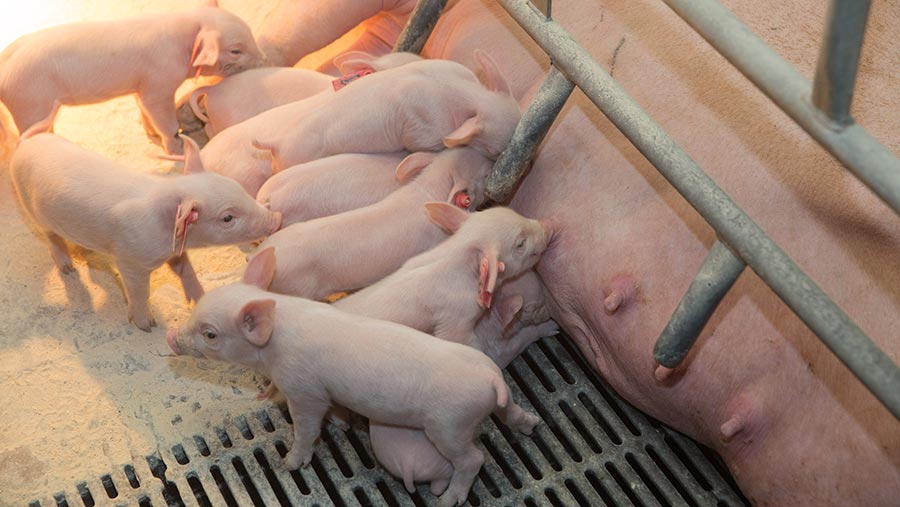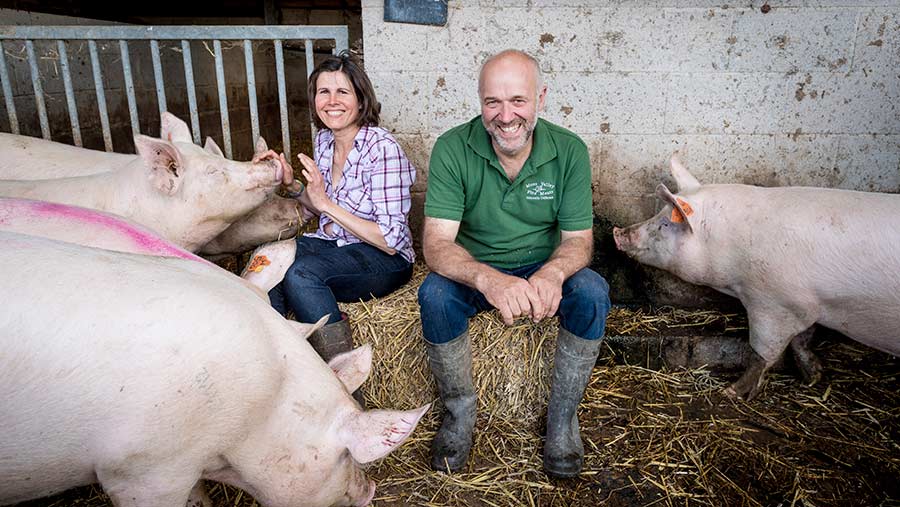Complete guide to feeding creep to piglets
 © Tim Scrivener
© Tim Scrivener Creep feeding is key to the piglet’s gut development and growth pre-weaning, helping prepare it for smooth weaning and good lifetime performance.
Dr Sian Nichols, UK pig nutritionist at Harbro, says its main purpose is to condition the gut and stimulate enzyme production, ready for weaning.
She adds: “Age and maturity of the piglet’s digestive system are just as important as weight at weaning, so producers need to make sure bigger piglets are eating enough creep as well as the smaller ones.”
To rear strong and healthy piglets, farmers should focus on minimising stress and providing good hygiene and water quality.
Feeding strategies also play a part, and some farmers also use to improve outcomes with larger litters.
See also: 14 top tips to improve number of piglets per sow
“More herds are now weaning 13 or more piglets per sow which has increased the need for supplementary feeding.” she says.
Below, Dr Nichols gives some practical insight into what farmers should focus on when it comes to creep feeding piglets.
Advice on introducing creep feed to piglets
- Creep can be offered from just a couple of days after birth and, while intakes are very low at that stage, it offers smaller pigs another option to get the nutrients they need.
- The aim should be for at least 500g of creep intake per pig over a typical 26-day pre-weaning period.
- When a litter’s creep intake is good, variability has been found to be much lower when they reach 12 weeks after weaning.
An extra kilogram of weight at weaning can result in an extra 4kg when pigs reach slaughter.
How to feed creep
- In the early days, the priority is survival rather than growth, so creep is about offering an appealing, palatable alternative to sows’ milk.
- Make sure you don’t overfeed. Milky creep goes sour very quickly so feed little and often – three times a day ideally.
- Intakes won’t increase rapidly until week four.
How to encourage intakes
- Position creep feeders near the sow’s head wherever possible so that they don’t become soiled.
- The freshness of feed will help stimulate interest so creep bowls or troughs should be cleaned at least once a day.
- Regularly check water quality and flow rates too, as the amount pigs eat is directly related to how much they drink.
What ingredients to feed
- It is important to invest in a good-quality creep. While the price per tonne of creep feed is high, the quantity fed is very small – typically the cost a piglet is only about 50p.
- When it is first offered, creep should be highly digestible, containing a high proportion of milk.
- This should be balanced with some plainer, simpler ingredients such as cooked oats and fishmeal, to start familiarising the piglets and their digestive systems with these as early as possible.
How to ensure a smooth transition post weaning
- Between weeks three and four, producers should phase in the diet that piglets will eat after weaning, which will help reduce stress at weaning.
- This should contain more uncooked materials and help stimulate enzyme production.
- Maximise feeding space for newly weaned piglets by providing additional long sheep troughs and, again, feed little and often – three to four times a day for the first couple of days.
For more information on creep feeding have a look at this AHDB factsheet.
Case study: Improving transition success
Farm facts
- 200-sow farrow-to-finish herd and butchery business
- Based near Sheffield
- Three-week batch system
- Slatted housing throughout
- Danish Duroc genetics
Producer Karen Thompson and her husband Stephen believe feeding a creep crumb to piglets from their 200-sow indoor herd is aiding transition success.
They feed a creep crumb rather than a pellet as it can be easily made into a gruel in the run-up to weaning.
This is in preparation for the first five to seven days post-weaning when gruel is fed to all pigs, to help complete the transition from milk to solid feed.

Karen and Stephen Thompson © Jim Varney
A crumb is also easier to explore initially as it gets stuck to the pigs’ noses and they can lick it off.
Creep is offered from 10 days, a little at a time, as often as necessary – typically twice a day to begin with, rising to three times daily.
Both the milk and the creep crumb are fed in round plastic feeders which are easy to hook in and out of the slats for daily cleaning.
Mrs Thompson says: “The aim is to make sure the piglets clean up before the next feed while providing enough opportunity to eat it. Intakes can reach 2.5-3kg of creep per litter per day for the most forward litters towards the end.
“They also have supplementary milk from two days old, which we mix and feed by hand.
“Offering an alternative source of feed as early as possible helps change the piglet’s mindset from relying completely on mum to realising there is food elsewhere, and we find that using supplementary milk hand in hand with the creep supports smaller pigs and larger litters.”
Mrs Thompson is interested in whether creep feeding from an earlier age could bring further benefits for their system.
Pigs are weaned, on average, at 25 or 26 days with the biggest typically at 8.5-9kg.
They are split into three groups of small, medium and large pigs, so they can be managed separately post-weaning.

